Podcast: Download (Duration: 37:56 — 34.9MB)
Get Notified Of Future Episodes Apple Podcasts | Spotify | Amazon Music | Android | Blubrry | Gaana | TuneIn | Deezer | Anghami | RSS | More
In the podcast:
01:44 – A bit of background
03:11 – Where the analytical bent comes from
05:18 – A certain kind of client
07:37 – Why not off-the-shelf?
08:35 – The tools they use
09:51 – The recommendation process
11:38 – Are messes normal?
13:32 – The four-stage Facebook strategy
16:15 – Selective advertising
18:39 – Best-working lead magnets
20:00 – The biggest mistakes people make
24:01 – The offer is everything
25:01 – Picking the ideal client
26:18 – The tools that track
28:52 – From engagement to conversion
31:25 – What is Josh excited about?
33:33 – A three-item checklist
36:15 – Parting thoughts
Let James set you on track to success with his personal business coaching
Transcription:
James: James Schramko here. Welcome back to SuperFastBusiness.com. Today we’re talking about traffic. We’re talking about funnels. I’ve brought along a friend of mine, Josh Marsden, to talk about such things. Welcome, Josh.
Josh: Hey, James. Thanks for having me.
James: It’s really good to have you along sharing some stuff, because I know how generous you are. And you’ve been in this, I suppose we’ll use the word “funnel business” for quite some time. I think you were one of the very early certified people in some of the popular software applications out there.
Josh: Yep, yep, that’s correct. Yeah, Infusionsoft. Also Digital Marketer, which, you know, isn’t a service, but I was the second Digital Marketer certified partner back in late 2014. And yeah, I’ve been doing this now for over five years. I’m still loving it. I’m just very fortunate, very blessed to have found essentially my niche, something that really drives me every single day.
A bit of background
James: So just a little bit of history. We met in Austin, I was at Ryan Levesque’s ASK master class, and you were there, learning the craft. I think it’s great to go to events like that to educate yourself to see what the best techniques are. Of course, you probably implement those sort of things for clients with your agency, which you have over at CVOAccel.com. Do you find that that sort of continuous education is a big part of what you do?
Josh: Oh, yeah, absolutely. I mean, in this crazy world of online marketing that we both participate in, especially if you sell services that have to do with implementing the latest and greatest strategies and tactics when it comes to digital marketing, I mean, you have to stay up to date on everything that’s going on in the industry.
“You have to stay up to date on everything that’s going on in the industry.”
That’s actually part of the reason why I love what I do, too. Because when I was younger and I was in corporate America, so to speak, I was bored at times. I wasn’t getting challenged at times. And now I have no shortage of challenges, because there’s always something that I have to learn in order to stay ahead of the curve and be at the top of my game when it comes to helping clients generate leads and sales profitably online.
James: So, Josh, what did you use to do in the corporate world?
Josh: Yeah. I’m laughing because you and I kind of have a similar background. I was 10 years in sales or sales management. That’s what I did right before I started my company.
Where the analytical bent comes from
James: Right. And it gives you a great ability to communicate, having those sort of skills. And then you’ve obviously got some technical expertise, where you’ve been able to translate the sales process to happen in a more automated way. And I think you have a real affinity for process. Where did that come into it?
Josh: You know, that’s a good question. I think there’s a combination of different factors that have really contributed to me being strong when it comes to just process and just being analytical. You know, altogether, just a few things.
I grew up a military brat. So I was very disciplined growing up, I was very organized growing up. I had to be that way all the way until I graduated high school. And then after high school, I luckily still maintained a lot of those traits. And I think that has kind of led me to having that type of approach when it comes to my company’s work.
And then I also, when I was younger, I got into computer programming in high school, and it was just something I did, basically as an elective. And then when I went to college for the first time, I actually decided to major in computer science. And then that didn’t work out, but it was essentially giving me some of that technology background early on in my life.
And then on top of that, when I was 18, I started building computers, back when, I think the first computer I built was based off the AMD K6-2, which is a processor that’s super old now. I mean, it’s like 20 years old. But I’ve just been building computers and I’ve always had, like, you know, a technology kind of background ever since I was really young. And even though I never necessarily got into that as a career up until starting up my own business, it was something that I’d always spent a decent amount of time in, you know, even growing up and working in corporate American sales and sales management type positions.
James: I love it. We probably have to come up with some kind of geek alert there. I like how you chuckled when you mentioned the technical specs of your computer. That’s a giveaway, my friend.
Josh: I know.
A certain kind of client
James: In my travels, as a business coach, I’m often finding business owners who are brilliant and have a particular expertise or specialty. And initially, some of them try and tinker around with the tools themselves. And I think some of the companies are really marketing themselves as a do-it-yourself solution. And then they get to a certain point where they have to cross that threshold. And they either have to bring people into their in-house team, or they deal with a service consultant, someone like you, who is their tech person slash marketing arms and legs, the person who’s going to build them funnels and automation and systems and is like the Dr. Doolittle, knows how all the tools work together.
And I think this is the sort of client that you’ve attracted. What sort of entrepreneurs are coming to you for help, typically? What sort of classifications? Because I think that’s going to help someone listening to this identify where they’re at in the hierarchy of getting help with tech.
Josh: Yeah, yeah, you know, I think that the best clients that we’ve worked with are successful companies in their own rights, are typically around mid six figures, more or less, and, and they’re just really needing help, just like what you just said. They need help with all the tech implementation, with having like, someone in marketing day in, day out to collaborate with on marketing strategy. They need someone that really needs help with data, with analytics and can go through performance reporting, and really diagnose what’s happening in their marketing so as they can take their marketing to the next level. Those are typically the companies that we work best with.
And on top of that, companies that don’t want to deal with trying to do that stuff in-house, whether it’s them or going through the process of trying to find the perfect team members, which is never easy. They don’t want to deal with that. They don’t want to go through that process. They don’t want to go through the potential opportunity loss or all the stress and all the challenges that come out of trying to train a team member. And they’d rather just reduce all that liability, basically, and just go to a professional agency that does great work and just hire them to team up with them to help them deliver the results that they want in their business by using online marketing effectively.
Why not off-the-shelf?
James: How realistic do you think it is that someone couldn’t buy an off-the-shelf funnel software and just handle everything themselves these days?
Josh: Can you say that question one more time?
James: How realistic do you think it is that someone could buy an off-the-shelf funnel building software (and there’s various tools around that do this) and just manage everything themselves?
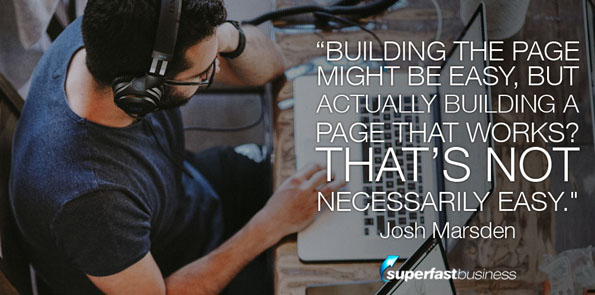 Josh: Right, right. You know, it’s not as easy as some of the marketing out there from ClickFunnels and all these other companies out there. It’s not as easy as people make it out to be. I mean, sure, getting a page built out definitely is much easier than it was 10 years ago. But getting it built out in a way that makes it professional, that really speaks to the brand well, that has really good solid copy that converts, I mean, you know, that’s not easy. So building the page might be easy, but actually building a page that works? That’s not necessarily easy.
Josh: Right, right. You know, it’s not as easy as some of the marketing out there from ClickFunnels and all these other companies out there. It’s not as easy as people make it out to be. I mean, sure, getting a page built out definitely is much easier than it was 10 years ago. But getting it built out in a way that makes it professional, that really speaks to the brand well, that has really good solid copy that converts, I mean, you know, that’s not easy. So building the page might be easy, but actually building a page that works? That’s not necessarily easy.
The tools they use
James: Yeah, I think you start layering a few tools. If you put in a chatbot here, and a webinar there, and a couple of other tricky things, it can get a little bit complex. I’d love it if you could just rattle off a list of the types of tools that you are working with on an ongoing basis, just to get a range of how agnostic your service might be.
Josh: Yeah, that’s fine. So you know, we really work with Infusionsoft, Ontraport, Klaviyo. We also work with ClickFunnels or LeadPages, those are typically our two funnel-building softwares. However, you know, if someone has WordPress, and they want to stick to WordPress, not have to agree to a subscription like ClickFunnels, we also use Thrive quite a bit to build landing pages.
And then when it comes to split testing and optimization, we usually use Visual Website Optimizer to be able to run the type of split tests, we want to run and also get access to the data that we want to get access to.
And then chatbot software. I mean, our two favorites right now are ManyChat and also SegMate. Those are two really robust chatbot marketing softwares that do really well for generating the type of results that we want to generate using chatbots with our clients‘ funnels.
Yeah, I think that pretty much covers like all the software that we typically use.
The recommendation process
James: Cool. So with this in mind, let’s say I’m a coach or selling high-ticket services, what sort of challenges do you deal with when someone’s coming to you and they say, “OK, I’ve got this program, it’s $10,000 or $20,000. Josh, I need help”, where are you going to start? What’s the sort of initial recommendation for how they get this thing working, from start to ending up with a subscribed client?
Josh: Sure. I think it first comes down to, like, you’ve got to diagnose what they have, what that business has, first. You know, what sales pages do they have that work? What emails do they have that work, for example. And then, once you’ve identified what’s working, then you really want to be able to build around that and get everything very consistent and congruent with each other too, at the same time.
So that’s typically the process that we go through, when we’re working with a brand new client, in that same circumstance you just gave me. If that were someone that came to us, I’m going to spend a few hours with them, and just really learn more about the business, identify what’s working, see what they need to do differently to get their performance where they want it to be, see what missing elements that they have that’s missing from getting that funnel to the performance, like, objective that they want to be at, as well. And really just approach it that way, when it comes to the scope and the overall strategy. And then from there, obviously, it’s just a matter of execution and process, which comes down to the creative work, the implementation work, and then, of course, getting all the analytics and all the numbers right so as you can measure and track everything. And this way, you can optimize it to get it to where you want it to be at.
Are messes normal?
James: Do they typically come to you with a mess, like things everywhere, on different platforms and programs? Or, you know, is this normal that people get a bit out of control, adding a bit here and a bit there? Or are you getting people sort of at an earlier stage where they’re just like, “OK, I’ve got a great idea. Can you make this sell?”
Josh: Yeah, it’s normal. I mean, if you’re a successful business, then you probably have just all sorts of messes in your business, so to speak, when it comes to funnels and landing pages and emails and sequences and all sorts of stuff just slapped together, basically. So, yeah, every single time we work with a client, it’s not working from scratch, it’s typically working from existing assets. And my job as a marketing consultant early on, when working with a new company, is to really, basically, look through everything and see what’s reusable and what’s not. And, like I said before, help them accomplish whatever their goal is, based off of what they already have in their business, and what we can provide for them.
James: Cool. And do you have a favorite strategy? Like, is there one that works really well, each time you execute?
“There’s a lot of different things that go into every single strategy.”
Josh: Yeah, there isn’t necessarily a consistent strategy because there’s a lot of parameters. There’s a lot of different things that go into every single strategy. You know, there’s the offer, there’s the price points, there is the market who you’re targeting, all that stuff. There are definitely some standards on like, Facebook advertising, for example, that I can speak to, that are consistently working amongst all of our Facebook ad clients. Would you like me to speak to that?
James: Yeah, I’ll take anything that you’re prepared to share that you know is working quite well, because it would be a good checklist for someone listening to this to see if they’ve already got it in place, or if they want help to get it in place. So let’s start with that.
The four-stage Facebook strategy
Josh: Sure. Yeah, that’d be great. So, right now, with Facebook, what’s really working well is just having a layered Facebook ad strategy. And what that means is, really having these four stages really focused on your Facebook advertising.
The first stage is the awareness stage, which is how you’re creating authority in the market that you want to attract. And this comes down to your content, whether it’s blog content, or video content. This comes down to articles that maybe you’ve written, or you’ve been seen in. It comes down to that type of content, to attract people into the top of your funnel from a cold audience. And on top of that, when you’re using that type of content, you’re able to reach a thousand people for anywhere between five to 15 bucks, which is really cheap.
 Once they’re in your funnel, then you want to really engage with them. And so this is where you want to show them some of your best content. But at the same time, you want to show who you are as a brand. And typically the brand’s represented by, like, the point man or point woman, which is like the leader of the business. And so, typically, in small business, you are your own brand, is what I’m getting at there. And so, you want to show yourself authentically, in engagement type content, where you’re going over your views, where you’re talking about different experiences, where you’re talking about different case studies – that type of content in the engagement stage.
Once they’re in your funnel, then you want to really engage with them. And so this is where you want to show them some of your best content. But at the same time, you want to show who you are as a brand. And typically the brand’s represented by, like, the point man or point woman, which is like the leader of the business. And so, typically, in small business, you are your own brand, is what I’m getting at there. And so, you want to show yourself authentically, in engagement type content, where you’re going over your views, where you’re talking about different experiences, where you’re talking about different case studies – that type of content in the engagement stage.
And then the third stage is the conversion stage. And this is the stage everybody wants to get to right away. But if you do it in this sequential order, you’re going to really reduce your cost per lead, and your cost per acquisition, and also increase your profit from Facebook advertising. And so the conversion stage is just all about getting them into your funnels, whether it’s a lead gen funnel, whether it’s a purchase funnel, depending on what type of business you have or offer you have. It really just comes down to what’s the best strategy to get people to become customers. And it comes down to a lot of different factors there. So either way, it’s just about converting them at that stage.
And then once you have converted them, it’s about monetization. So, what are you doing with Facebook ads to be able to maximize your customer lifetime value? And that comes down to using dynamic product ads, it comes down to offering something more, like, high ticket to your customers. That’s what it comes down to at that stage.
So that is universal, that strategy is universal. And you could even expand on that with using like, Google AdWords and other ad platforms out there to be able to be everywhere, essentially, once they’ve come into your funnel. But Facebook is still great for your awareness stage. And you can definitely focus on Facebook alone throughout all four of those stages. But you can definitely expand out to other platforms, so this way, you can maximize your return on your investment.
James: And I imagine you can get a pretty effective and powerful campaign if you’re only advertising your conversion to the people who have engaged with you, rather than everybody. The people who have watched a certain amount of views, that sort of stuff.
Josh: Yeah, absolutely. I mean, we have a client, for example, that is literally at 1200 percent return on ad spend. And they’ve been with us advertising for about three months. And I mean, they’ve spent, just to give you an exact number here, they’ve spent just under 17 grand, and they’ve made back just over 207 grand. So I mean, this process works, this strategy works, and it can definitely generate results fairly quickly as well. There’s definitely a number of factors that go into it, but that’s just one example of how this strategy can work really well for a company.
James: How important do you think the offer is? Have you found offers that you just can’t make convert?
Josh: Yeah, you know, that’s a good question. Yeah, we have, and from an agency perspective, we’re much more careful now these days in how we set expectations with clients, and how we’re evaluating potential opportunities to help companies as well. We definitely don’t want to over set the expectation that we can take an offer that necessarily hasn’t been tested, and we can get it to make a ton of money. I mean, you know, we can’t set that expectation.
We definitely usually work with companies that have a validated offer, because we did find, let’s just say, two years ago, or more, even, we did find that there were cases where we were helping companies and they had offers that hadn’t been necessarily validated, and we were putting an entire funnel together. And unfortunately, the funnel didn’t work out and so we’ve, since then, really learned that those are not our best clients, our best customers.
And so, we really try not to work with too many companies like that, unless we have clear expectations and they know that with marketing, there really isn’t any guarantees. But if you put a lot of work into the research, you put a lot of work into the entire process behind creating a funnel and creating a campaign or a launch, then you could have a good potential of it being successful. But at the same time, it’s still potential. And so we’re very careful as far as what companies we work with when it comes to offers that have not been validated.
Best-working lead magnets
James: And what would be your favorite lead magnets that you would love someone to bring to you and say, “OK, this is what we’ve got to put out into the marketplace”? What one’s worked the best, do you think?
Josh: Yeah, so these days, typically lead magnets that work the best are quizzes, for one. Quizzes have not lost their relevance. The free PDFs and free reports and free guides, they still do work to an extent, but we definitely are in a day and age right now where people don’t want to jump through hoops. They don’t want to give their email information, you know, too quickly to get a free guide or to get a free report. That’s why having that four-stage strategy built out in your business with Facebook ads really helps because then you can really create that relationship before you ask for anything, including an email address.
So, yeah, honestly, quizzes and mini-classes and video trainings, those are typically the best, like free reports or free offers, I should say, that do really well right now.
James: What about a book?
Josh: Yeah, that’s a good question. Honestly, I can’t say that I’ve ever had any experience offering, like, a book. Ebooks, yes, but not actual books in our clients’ funnels. So I can’t really comment on books, whether or not they’re effective or not as lead magnets.
The biggest mistakes people make
James: Very nice. So what are the biggest mistakes that you see people making? I’m sure you watch people’s marketing from the sidelines. Perhaps, you know, not clients, just people out there in the marketing space. Because you’re keeping an eye on what’s happening. What do you see and you think, ‘Aww, someone should tap them on the shoulder and let them know this isn’t going to work’?
“Whenever you’re advertising, you need to have everything measured.”
Josh: I think for one, whenever you’re advertising, you need to have everything measured. I see that time and time again, that people and companies are not making decisions based off of measurable results. And that’s definitely a big mistake. You don’t want to ever do anything without having ROI in mind, in my opinion, when it comes to business and marketing. I mean, besides that, I think that over complicating funnel processes, which is something that even I’m guilty of, at times, which you’ve been coaching me on, obviously, James.
James: I was just quietly smiling there. I often find, when I work with someone who’s got a lot of genius talent, they can tend to get stuck in it. And it’s my job, because I don’t have that talent. I don’t get too caught up in the small stuff. It’s sometimes, you know, it’s like the mechanic with the beaten-up car. They get so obsessed about one part of it, they miss the whole thing. But I think complexity is, it’s kind of a magnet in this world. If you’ve grown up on computers, and you love marketing, and then there’s all these new tools coming out, I can only imagine that the magnetic pull to be digging around and tinkering with it is strong.
Josh: Yeah, yeah. That’s actually, I know that we’ve talked about this a little bit. But that’s a good point. I think it’s like a shiny new toy that comes out you want to play with.
James: There’s the other factor too. You know, when I started out, I was building my own websites. I’m sure anyone listening to this for a long time would know I used to sell websites software as my first affiliate recommendation. And I was building my own website. And I spent an inordinate amount of hours messing around with font sizes, and choosing different color panels for the layouts. I had most things sorted when it came to how the software worked, but I wasn’t focusing on the things that matter, like the sales copy or driving traffic.
It took me a long time to make any money doing that affiliate business, because I spent too much time trying to learn this stuff that in the end, I never touch that stuff anymore. I don’t even login to my WordPress site. I have team members who do this.
But even that being said, my team members are really talented and skilled and have been with me now for a long time, but we still get outside help for some of the more technical bits. Like, particularly reporting and API’s, and just anything new or technological, we’ll bring in help so that we can get the result much faster instead of trying to learn it ourselves, even though I’ve got people in the team who can do it. And over time, we might take it over. But generally, I think there is definitely a strong need for people who can just come in and make everything work for sure.
Josh: For sure. I mean, it just saves a lot time. Also, it allows the business to stay in their zone of genius, so to speak, whether it’s serving clients with more energy and more time, or whether it’s creating more content, or whether it’s creating more offers, or whether it’s just reducing time in your business, so you could have more of a work life balance, which is key to longevity. I think it’s smart to do that. I mean, just like you said, just a second ago, the speed of the results comes much faster when you have hands in your business that have experience and have talent, have the skill to be able to deliver those results faster.
The offer is everything
James: Yeah, you either spend some money, or you spend time. And I spent a lot of time in the beginning, and now I’d rather spend some money and get the results. And I think a lot of this comes back to having something to sell. And I can’t stress this enough, it’s a topic in my book, which is called Work Less, Make More, available on Amazon and Audible.
Josh: Awesome book!
James: Well, that’s the extent of the advertising on this podcast.
So having that offer means everything, because without the offer, it’s hard to get the revenue to put back into hiring the people who can get you the revenue to put back into hiring the people who can help you get the revenue and to deliver the results. And you end up with a big pile of profit. But you have to have the offer.
So I imagine there’s people out there with an offer that’s not that great, who are going through Facebook ads supplier after Facebook ads supplier and making them the bad guy. And now you mentioned you’ve got strong filters, which is fantastic. And something that I would advise any service business is to be very careful who you work for, in the same way that I’m pretty selective about who I want to work with, where you can maximize the results.
Picking the ideal client
What would be on your checklist of ideal things that a client would have for you to think they’re a good person to work with?
Josh: Sure. For one, I know this is going to sound maybe a little cheesy, but we have to like that person first. I mean, you just have to have rapport with that person, you know, because if you have rapport with your clients, it just creates a better experience all around, and just more synergy, and it sets everybody up to be successful together. So, that’s the first thing I would say.
But besides that, it would have to do with, do they have voids in their business that we can really help them with? Do we see opportunities to really magnify their results because they’re not doing quite a bit in their business they could be doing? Or they’re doing things in their business that they could be doing much more effectively, that we can really help them out with. Besides that, just having a good solid validated offer or set of offers, that we can really magnify with the right strategy, right approach, and also the right split testing all the way between traffic and the funnel.
Those are basically some factors that we look for when we’re evaluating whether or not we want to work with a company that is thinking about coming on board with us.
The tools that track
James: Right. So, I want to just go back to something you said before about ROI being important and measuring and tracking things. Do you have favorite tools for that?
Josh: Yeah, well, for one, just having all your ads reporting set up, whether it’s Facebook or Google, you know, just making sure you really have your ads reporting set up. And I mean, all the way down to the goal that you’re really pushing for, the conversion goal. Not just basic metrics like CTR and CPC, but the amount of customers you’re generating, the cost per customer, or if you’re going for lead generation, measuring that appropriately and just having it precisely tracked. That’s key in order to be able to do advertising right, which is, you know, focusing on ROI.
When it comes to the funnel, nowadays, a lot of platforms give you some solid stats to start with. Like, ClickFunnels, for example, does give you the step-by-step funnel conversion rates. If you want to get deeper into that, you definitely need to go beyond what ClickFunnels or any other platform gives you to get details like, do people scroll down on the page, do people click on the button, for example.
Those are what I call micro conversions. You’d want to measure that with, at minimum, Google Analytics and Google event tracking, which obviously, you know, Google Analytics and Google event tracking is a hundred percent free, you just have to know what you’re doing to set those up. But otherwise, I mean, Visual Website Optimizer, which isn’t free, but it’s a very robust tool. And I know there’s others out there very similar to VWO, and I’m sure they’re all great as well. We just always use VWO. That’s something we have in our agreements with clients, too, when we’re doing a split testing and optimization, that they have to get Visual Website Optimizer, the testing version, which is 60 bucks a month. But that gives you access to detailed data, so as you can really break down every step throughout your funnel and really identify where there’s fallout, where there’s opportunity to optimize, to improve overall performance. That’s what we do.
James: And the other thing that came up in my interview with Scott Degrosseillers from Wicked Reports is the amount of time that it can take to get that ROI. It was on the data that he had collected, which was a lot, $1.5 billion in sales, I think the average time was like, 45 days to get the return on investment. So he was talking about how tripwires, you know, it’s quite rare that they would actually work out of the gate up front as readily as we might have expected they would, from all the hype that’s around on them.
From engagement to conversion
When I was looking into my own analytics in Wicked Reports, I saw that most of my conversions happen between 15 and 60 days. And I think part of that is because my top conversion device is an email sequence that takes about two weeks to unfold to the call to action to purchase. That will be there where we go from the engagement to the conversion. Have you seen similar data or something different in terms of how long it takes to get that return?
Josh: Yeah, so that metric, for example, it’s definitely important. But it’s more important, in my opinion, when you’ve got a very, very robust, successful business, let’s just say, doing high six figures, or early seven figures. Because then at that point, you really are trying to identify the little hinges that swing big doors, you know, throughout the funnel. And so, you really want to know what specific ad is, for example, leading to the lowest cost per conversion and the highest conversion all together from the ad itself. Because then that’s a leverageable point in your funnel that you can really maximize, to get more leads.
Or in your example that you just stated, if it takes, let’s just say, 14 days to be able to convert a brand new lead to a customer, where does that happen? And then, what can you do to really double down right there so as you can decrease the amount of time it takes for them to convert from prospect to customer? That’s where you really do need access to deep data.
And that’s why Wicked Reports is awesome. Because when you have that level of a business, then you’ve basically surpassed what Google Analytics and Facebook ads reporting and Google Ads reporting and some of those more basic free reporting softwares can do for you. Because now you really need to identify where those little hinges are that could swing big doors in your business to be able to really scale and get the highest return on your investment.
James: Such a great point. One thing that I did to speed it up, after seeing that data, was put a specific call to action in the very first email with a fast path, letting people come through straight away.
Josh: Nice.
James: And that has opened up the doors, which is good, and I’m expecting that the data will change. And then of course, the big event that was happening at 14 days was the first email. So I’ve rewritten that email to test if we can increase our conversions from that email. So I’m looking for our overall percentage of conversions from that entire sequence to improve. So really, really good stuff.
Josh: That’s awesome.
What is Josh excited about?
James: What other sort of exciting or interesting things are on your mind at the moment that you look forward to working on when it comes to maybe some campaigns you’re working on now, or are about to? What sort of things excite you? Where do you see the opportunities that might be worth putting some attention on if it’s not already there?
Josh: Yeah, well, right now, we’ve got two back-to-back kind of promo slash launches that we’re embarking on as of this recording. So I’ve got that basically on my mind that I’m really excited for. My team has been doing a great job though of getting us ready for these two launches coming up. And I’m just really stoked to get in there help my team really deliver maximum impact. And I’m basically beating previous high points for these clients and their previous launches or promotions. That’s just the competitor in me, because I always look for competitive angles so I can do my best work.
So I’m really excited for that, just because that’s something that really drives me and excites me, is just seeing numbers coming in. Like, when I spoke to those ROI results from one of our clients earlier, that excites me, I love talking about that stuff. And I love analyzing and looking at data and things like that.
But besides that, I also have my first book coming up really soon, as you know. It’s Facebook Advertising Strategies and Tactics for Ecommerce Companies, 2018 Edition. That’s going to be launching October 1st. And I’ve got a bunch of great people that have contributed to the book, including Molly Pittman, J. Trevor Chapman, David Schloss, Sam Bell, and Amanda Bond and a bunch of other awesome Facebook ads specialists out there. They’ve all contributed to the book. So I’m really excited to get this labor of love out there. I mean, I’ve literally been working on it since I think, March of this year. So it’s been a process, as you can imagine, but I’m excited. I’m stoked to get it out there and deliver a lot of value. So that’s what I’ve got going on right now that excites me.
James: Well, it sounds like your book funnel’s going to be fine-tuned soon.
Josh: Yep. Yep. Has to be.
James: Nice.
A three-item checklist
So if someone’s listening to this, they’ve got an ecommerce business or a coaching business, or they provide a service like you do, what are the three things that you would have them go and check on as a sort of a checklist, as a result of listening to this podcast? What sort of things would you expect that someone might have written down that they should go and focus on? If you could wave a magic wand and have them go and check three things, what would they be?
“You want to know how effective every piece of marketing material is in your funnel.”
Josh: Well, for one, make sure that you have everything measured and tracked all the way up to, obviously, the overall ROI. But you also want to know all your step conversions. And you want to know how effective every piece of marketing material is in your funnel. And if you don’t, then that’s definitely something that I would recommend, like spending some time on. So this way, you can maximize your efforts and maximize your return on your ad spend.
Besides that, I would also take a look at your funnel and see where you have leaks. See where you have opportunities to bolt on additional follow up sequences or follow up channels, whether it’s with emails, or whether it’s with chatbots. You know, they all have potential to make a deep impact on your overall ROI and results.
Besides that, also take a look at what you can do to offer more with your customers because that’s an easy, quick win that most businesses can usually achieve. If they can identify a good offer that they can make to their customers, a bigger offer, or offers more value or more impact or at a faster speed, that could be a huge opportunity as well that I would tell your audience to be keen on.
So, yeah, I would say those are the three areas that business owners really need to take a look at, to be able to maximize the impact and just the overall sales in their business.
James: I love it. I love talking to someone like you. It’s like a subject matter expert. I haven’t given you any prompts for this discussion. And I love that you know your product so well, that you can come up with three off the cuff like that.
Look, I just want to say personally, I’ve really enjoyed working with you, because I get to see behind the scenes, and I know how much you care about what you’re doing, and how passionate you are about your field of expertise. And I think that’s something I encourage people to get to. Sometimes there’s a means to an end in the beginning, where you’re doing something that’s not in your pure passion wheelhouse. But I think it’s great when you get there, because your work just shines through. So it’s been awesome getting to see how you operate and how much you care about your processes and the team and getting customers results.
Josh: Thanks, man.
James: Yeah, I just want to say thanks for coming and sharing this stuff. And good luck with the book. I know that’s going to go well. I’ll make sure that we come back and link to it once it’s published.
Parting thoughts
So Josh, any final thoughts regarding funnels and so forth as we close out?
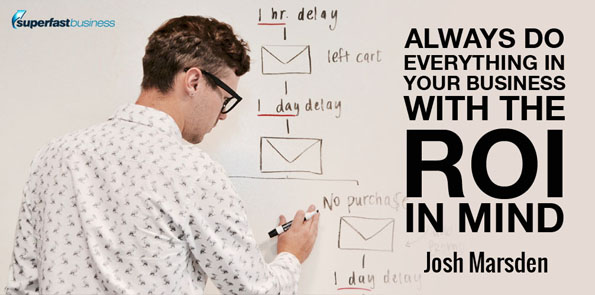 Josh: No, I would just tell your audience, just like I said before, just make sure you have everything tracked. Don’t do anything, when it comes to marketing or just anything in your business, investment wise, whether it’s time or money, unless you have an ROI in mind. Always do everything in your business with the ROI in mind. But I would just say, just make sure to have everything tracked effectively, because that’s typically the most common issue and problem that I see with a lot of companies that come over to my company and work with us. So, that’s the only wisdom that I would pass on to your audience right now.
Josh: No, I would just tell your audience, just like I said before, just make sure you have everything tracked. Don’t do anything, when it comes to marketing or just anything in your business, investment wise, whether it’s time or money, unless you have an ROI in mind. Always do everything in your business with the ROI in mind. But I would just say, just make sure to have everything tracked effectively, because that’s typically the most common issue and problem that I see with a lot of companies that come over to my company and work with us. So, that’s the only wisdom that I would pass on to your audience right now.
James: Thank you. Yeah, having been through that process of setting up tracking, I can attest to the value in knowing exactly where your opportunities are. You go from flying blind to flying with laser vision. So I’ve been chatting with Josh Marsden from CVOAccel.com. Legendary generosity. Thank you so much for sharing, and we’ll stay in touch and see what we can come back with in the future, especially after the book’s out, see which bits were popular. I’m looking forward to that discussion.
Josh: Yeah, sounds great. Sounds great. Yeah. And your audience too, if they want to reach out to me, they can always reach out to me. If they have any questions following this podcast.
James: Oh, that’s very kind. Thank you, Josh.
Josh: Awesome. Well, thanks for having me on. I appreciate it.
Get the resources and support your business needs to grow inside JamesSchramko membership
Liked the show? Stay on top of our episodes by subscribing on iTunes
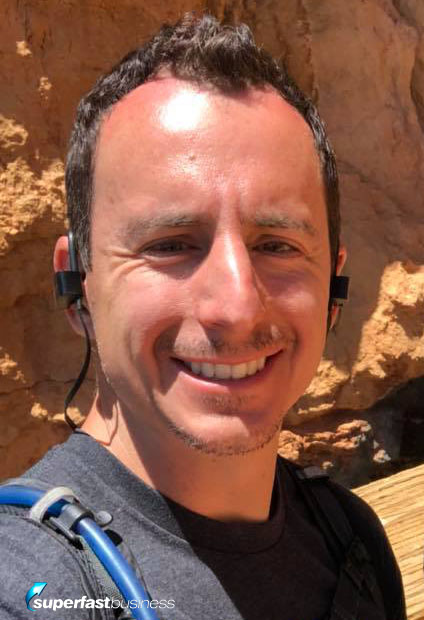
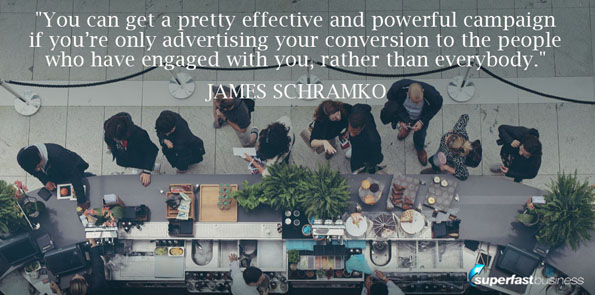



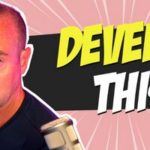





That’s all “spot on”. Loved those 3 quick tips especially
That’s all “spot on”. Loved those 3 quick tips especially
thank you !